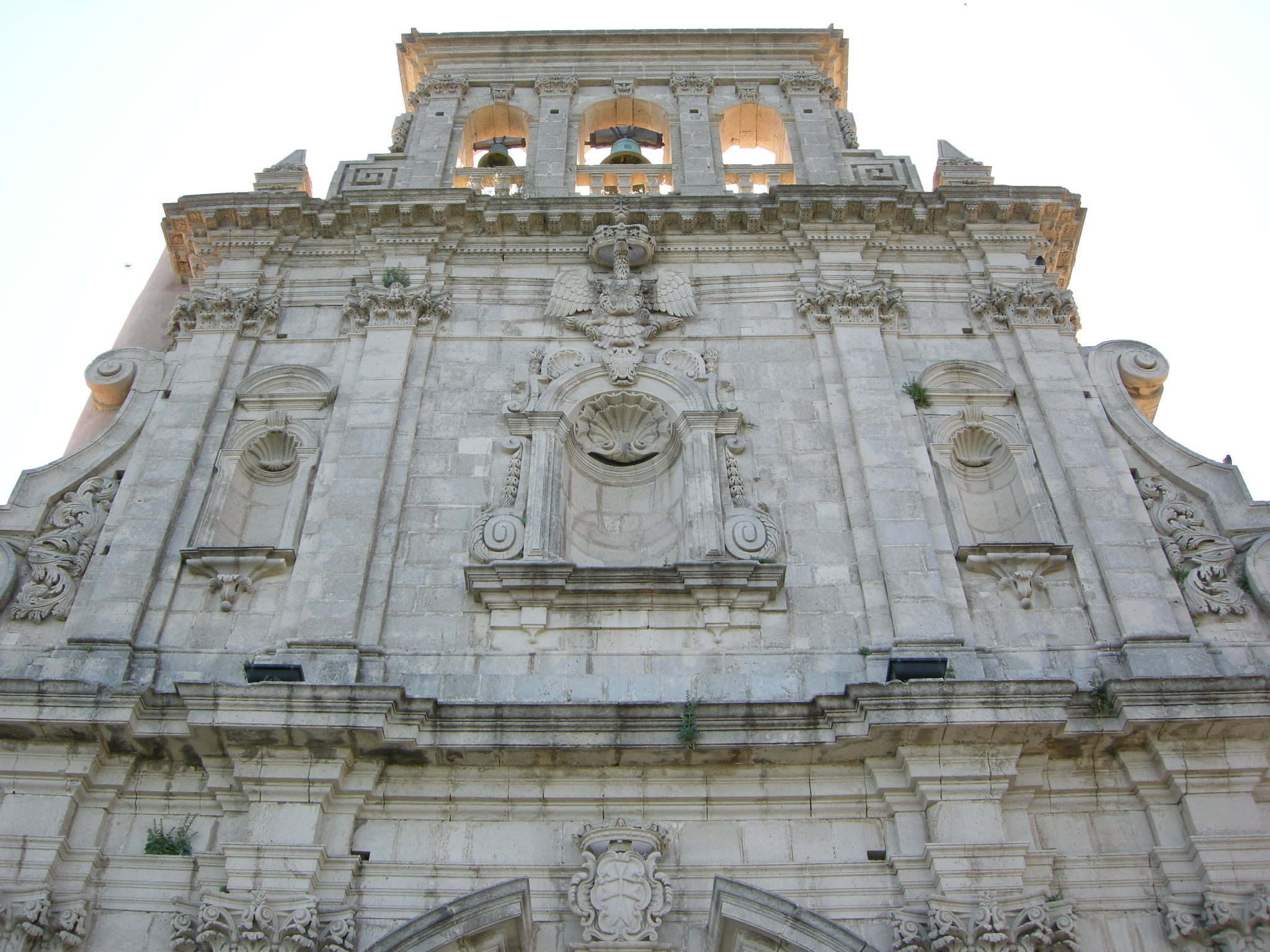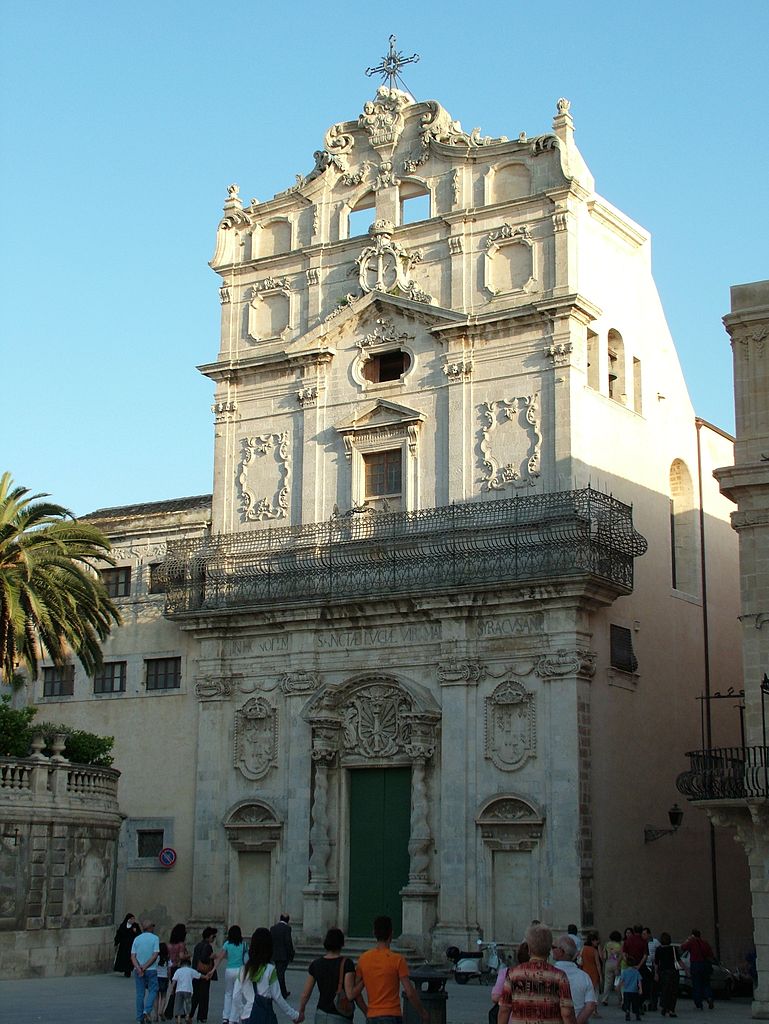Church of the Holy Spirit
Among Ortigia’s architectural artifacts, one of the most unusual is the Church of the Holy Spirit located along the east coast, one of the banks of the seafront on the island of Ortigia, near the Castello Maniace.
With its elegant and spectacular facade, it embellishes the initial stretch of the eastern promenade along the small road that passes in front of Piazza Federico di Svevia.
BACKGROUND HISTORY
According to local chroniclers, in the fourth century the bishop Germano (successor of Cresto) had four churches built in Ortigia, the Church of the Holy Spirit is the oldest of them.
It was followed by the churches of St. Peter, St. Paul and St. John the Baptist.
However, it seems difficult to believe that the bishop dedicated one of these churches to the third person of the Trinity, who was theologically affirmed in the Councils a few centuries later. We can suppose that, having lost the memory of the ancient dedication, only the most recent one has been handed down.
The date of construction of this structure, therefore, dates back to around 363 and for three years this was the only Christian church in Ortigia.
The church was built at the point where, according to tradition, St. Marziano sent by St. Paul of Antioch to preach the Gospel had landed.
This is testified by an ancient painting of St. Marziano that is kept inside the church and the inscription above the main arch of the church: de spiritu santo, prima post antiocheam.
It becomes the church of the Archconfraternity of Divine Love and the Holy Spirit of the Knights of the Faith and the Dove, established in 1652 by Monsignor Giovanni Antonio Capobianco, then Bishop of Syracuse, and legitimized in 1652 by a decree of the King of Spain.
Its members were obliged to “spread the faith, the cult of the church, the sacraments, perform services in hospitals, visit prisons and the hotel of pilgrims.
The medieval church underwent transformations as early as 1686 and the earthquake of 1693 damaged it in such a disastrous way that a new construction was necessary right from the start.
The Confraternity took advantage of this to rebuild it with a more sumptuous baroque dress designed by Pompeo Picherali.
The works began in 1727, but were interrupted after only four years to be resumed sixty-five years later and completed in 1797 by the most renowned architects of the time, Luciano
who adapted the project to the new taste of the eighteenth century.
The attribution of the architectural elevation to the architect Pompeo Picherali (as engraved on the beautiful baroque façade) is certain, while Luciano and Gaspare Alì carried out the third order, making changes and contaminations to the original project.

THE FACADE
Its facade stands out on the high shore of the eastern coast, characterized by a sandy inlet, with its characteristic membranes, very striking especially from the sea.
The prospectus is divided into three superimposed orders, two covered and the last consists of the three-light bell, a real terrace overlooking the sea. According to Privitera, it had to contain the bell coming from the demolished church of Porto Salvo. The dome with its eight meters in diameter represents the element of prominence and uniqueness among all the churches of Ortigia, it is in fact the only one totally visible.
The orders are divided by a protruding frame and marked by elegant pilasters, crowned by capitals of the Corinthian order, which slender the upward line of the facade.
These, not exploiting any movement due to the chiaroscuro, have a minimum projection limited to the only plastic game.
The first order is characterized by the broken tympanum of the portal, flanked by four niches.
The second is pushed upwards by the volutes that delimit it and is lightened by the niches, central and lateral.
The niches, surmounted by friezes, are a recurring element throughout the facade, while the side volutes of the second order and the pinnacles that flank the bell tower, refine the whole giving it preciousness and elegance. The two pinnacles that adorn the bell tower, also made of the same stone of the facade, perfectly preserve inlays and decorative coats of arms, including a double Latin cross, the symbol of the Archconfraternity.
The white limestone used is coloured with shades at dawn, giving the whole a spectacular effect.
INTERIORS
The search for greater sumptuousness is reflected in the rich decoration of the interior.
The interior, bright and imposing, consists of three naves bordered by groups of columns, added by Luciano Alì to enliven the structure.
The side altars are adorned with twisted columns and valuable plaster of Sebastiano Monaco. Of particular interest is the vault frescoed by Ermenegildo Martorana of Palermo, depicting the Virtue, which was saved by subsequent restorations. The canvas depicting St. Gregory by Antonio Maddiona is also valuable.
A beautiful spiral staircase, of the same white stone of the facade, leads to the belfry from which, in addition to the splendid view, you can admire the beautiful dome detached from the body of the church.
LITURGICAL LIFE
he Church of the Holy Spirit was the site of intense liturgical life for the rites of Holy Week and in particular of the Mysteries, which took place on Holy Thursday.
They were splendid scenic representations of a stage of the Way of the Cross, prepared by the brethren with life-size mannequins representing each year a different moment of the Passion of Christ.
On Good Friday, the hooded members of the Archconfraternity paraded through the streets of Ortigia with an oil lamp and dressed in their characteristic costumes: a white sack on which the crimson bodice with its gold embroidered coat of arms shone.
The visit to the church on Holy Thursday, during the traditional tour of the Sepulchres, was for all citizens a moment of intense religiousness and great curiosity. The statues and scenes decorated by the brothers offered a scenic and spiritual effect that attracted the faithful, tourists and curious from all over Syracuse.
The French painter Jean Houel, one of the protagonists of the Grand Tour nel 1700,
describes with amazement and admiration the sumptuous achievements of the feasts of Corpus Christi.
In the Journey to Sicily there is an engraving of his carts of the confraternities of the Holy Spirit and St. Philip during the Eighth of Corpus Christi, which shows how the two confraternities competed in pomp and magnificence.
For the occasion, the confraternity of St. Philip had represented with canvas, paper and wood, the city of Troy and the wooden horse, while the confraternity of the Holy Spirit, a fort with drawbridges and batteries of cannons.
The procession of the hooded members of the Archconfraternity survived, even though it was transformed, until the 1960s, when popular traditions, particularly religious ones, began to lose their prestige little by little.
Just from those years there was a depopulation of the island of Ortigia in favor of other areas of Syracuse, which led to a lack of interest in the liturgical rites and a lack of resources of craftsmen, who contributed free of charge their work and their work to achieve and participate in the activities of the confraternity.
THE CHURCH IS OPEN TO THE PUBLIC.
LOCATION: Isola di Ortigia
Address: Lungomare di Ortigia N° 2



